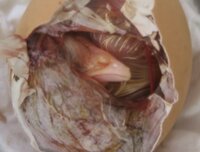Birdland80
In the Brooder
Hello everyone,
I'm a new member and so so happy to have found such a wealth on information here on BYC. I am mid way through my first time using an incubator, with a staggered hatch of both chicken and duck eggs (Taken randomly out of the eggs that were bound for breakfast, as we have NO broody hens wanting to warm them). My first question is about a chick that is on day 23-24 (isa cross golden leg bar). late. She hasn't pipped so I opened her air sac to see what was going on. The veining on the inner membrane is still enough to warrant her needed more time, however its day 23-24? How much more time should I give her? She is malpositioned as well. I have had three successful hatches, two normal and one assisted as she was stuck in the wrong end of the end. I have lost five that were all in the wrong position, and two hadn't finished absorbing the yolk. The other three looked totally normal, but seemed like they maybe had run out of air? They hadn't pipped, and were overdue, and I wish that I might have assisted them. Should i try and assist this current chick? Is there any way of taking the shell and then the outer membrane, leaving the inner membrane, so I can at least find her head/beak and give her a chance on not suffocating? Any advice is appreciated. Even constructive criticism
I'm a new member and so so happy to have found such a wealth on information here on BYC. I am mid way through my first time using an incubator, with a staggered hatch of both chicken and duck eggs (Taken randomly out of the eggs that were bound for breakfast, as we have NO broody hens wanting to warm them). My first question is about a chick that is on day 23-24 (isa cross golden leg bar). late. She hasn't pipped so I opened her air sac to see what was going on. The veining on the inner membrane is still enough to warrant her needed more time, however its day 23-24? How much more time should I give her? She is malpositioned as well. I have had three successful hatches, two normal and one assisted as she was stuck in the wrong end of the end. I have lost five that were all in the wrong position, and two hadn't finished absorbing the yolk. The other three looked totally normal, but seemed like they maybe had run out of air? They hadn't pipped, and were overdue, and I wish that I might have assisted them. Should i try and assist this current chick? Is there any way of taking the shell and then the outer membrane, leaving the inner membrane, so I can at least find her head/beak and give her a chance on not suffocating? Any advice is appreciated. Even constructive criticism



